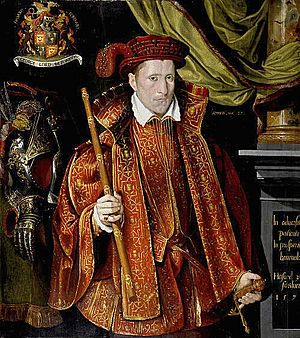Bertrand de Salignac de la Mothe-Fénelon facts for kids
Bertrand de Salignac de la Mothe-Fénelon (1523-1589) was an important French diplomat. He worked as an ambassador for France in both England, serving Elizabeth I, and Scotland, serving James VI.
Contents
Ambassador in England
Mothe-Fénelon started his diplomatic career as a secretary. This was in 1560, during a big religious change in Scotland called the Scottish Reformation.
In November 1568, he became the French ambassador to England. He took over from another ambassador, Jacques Bochetel de la Forest. The French king, Charles IX of France, asked him to explain a terrible event to Queen Elizabeth. This event was the St. Bartholomew's Day massacre, which was a violent attack in France. Mothe-Fénelon had to say it was needed because of a plot against the king.
After King Charles IX died, Mothe-Fénelon stayed on as ambassador in London. He helped arrange gifts and portraits between the English and French royal families. This included art from famous artists like François Clouet and possibly Nicholas Hilliard.
He was called back to France in 1575. This happened because Catherine de' Medici, the Queen Mother of France, wanted Queen Elizabeth to marry the Duke of Alençon. She thought a different ambassador, Michel de Castelnau, would be better at this negotiation.
Helping Mary, Queen of Scots
While in England, Mothe-Fénelon often wrote to Mary, Queen of Scots. They talked about political matters. He also helped her buy things like fabrics and sewing supplies. He even gave her advice on what gifts to give Queen Elizabeth.
In 1574, Mary, Queen of Scots, made a special gift. She embroidered a satin skirt with silver thread. She used materials Mothe-Fénelon bought for her in London. She later asked him for more silk thread, thinner silver thread, and taffeta for the lining. Mothe-Fénélon gave the finished skirt to Queen Elizabeth on May 22. He said it was a sign of friendship. He told King Charles IX that the gift was a success.
Mary hoped to meet Queen Elizabeth. She asked her contact in Paris, the Archbishop of Glasgow, to send her fashionable items. These included coifs (head coverings) embroidered with gold and silver. She also wanted the latest Italian ribbons and veils for her hair.
Mary planned to make more gifts for Elizabeth. She wrote to Mothe-Fénélon for advice on what Elizabeth would like best. She asked him to send gold passementerie (fancy trim) and braids called "bisette." Queen Elizabeth was always careful about Mary's gifts. She was even hesitant to try some sweets Mothe-Fénélon offered her. These were a gift from Mary's chancellor's brother. Elizabeth was worried they might be poisoned.
In September 1574, Mothe-Fénelon received a letter. It was from the former Regent of Scotland, now known as the Duke of Châtellerault. He also got a small portrait or miniature of James VI of Scotland. This portrait was likely based on work by Arnold Bronckorst or another "French painter." The letter and portrait were meant to be sent to Mary, Queen of Scots.
Diplomacy in Scotland (1583)

Mothe-Fénelon returned to England in 1582. In December 1582, he and another diplomat, François de Rocherolles, Sieur de Mainville, went to Scotland as ambassadors. Mary, Queen of Scots, sent him a secret code key and her instructions.
King James VI did not want Mothe-Fénelon to meet Esmé Stewart, 1st Duke of Lennox. However, by chance, the ambassador met the Duke of Lennox near Northallerton while traveling in December 1582. Mothe-Fénelon wrote to George Seton, 7th Lord Seton. Lord Seton offered him a place to stay in Edinburgh. In January 1583, he stayed at Robert Gourlay's house on the Lawnmarket, near the top of the Royal Mile.
Their discussions included the topic of a marriage for King James. The ambassador supported the Auld Alliance, which was a long-standing friendship between France and Scotland. He reminded James that his grandfather, James V of Scotland, had married French princesses, Madeleine of Valois and Mary of Guise. After a big dinner given by the Provost of Edinburgh, Alexander Clark, Mothe-Fénelon went to Seton Palace. Then he returned to Berwick.
In August 1583, a group called the Ruthven Raiders took control of Scotland's government. This was known as the Gowrie Regime. Mothe-Fénelon and Maineville were told to make sure James VI was free. They also continued talks about Mary, Queen of Scots, returning to Scotland. The idea was for her to rule with James VI in an "association." They also worked to help Esmé Stewart, 1st Duke of Lennox, who had been sent away by the Raiders.
Return to France
Mothe-Fénélon went back to France in 1583. He was against the Protestants until the end of King Henry III's rule. However, he then supported Henry IV. He passed away in 1589.
Writings
Mothe-Fénelon wrote several important works:
- Mémoires touchant l'Angleterre et la Suisse, ou Sommaire de la négociation faite en Angleterre, l'an 1571
- Négociations de la Mothe Fénelon et de Michel, sieur de Mauvissière, en Angleterre
- Dépêches de M. de la Mothe Fénelon, Instructions au sieur de la Mauvissière
His letters were published in Paris between 1838 and 1841.

